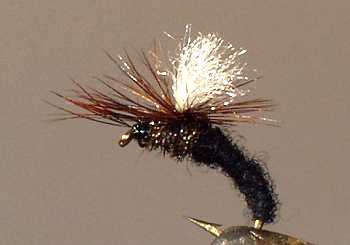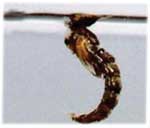Black Klinkhammer Emerging Nymph fly
Dutch angler Hans Van Klinken originally tied the Klinkhammer fly as an emerging caddis pattern to catch grayling feeding on them as they floated in the surface film.

KLINKHAMMER EMERGER FLY PATTERNS. Hook size 12 14 16 - $US each
THE BLACK KLINKHAMMER AND THE ISLE OF SKYE
The Black Klinkhammer is a must have fly when you go to Scotland fly fishing for brown trout. During a family holiday to the Isle of Skye in Scotland, I managed to have a few evenings fly fishing on the local lochs have visited the tourist spots and beaches with my wife and kids during the day. The loch was edged with heather and rough grass. The loch shores were abundant in fly life including the mountaineer’s and angler’s curse, the biting black midge. They have the ability to turn grown men into whimpering wrecks.
Having fished in Scotland and Northern Scandinavia quite regularly I had come equipped with a fly net that went over my hat, and a long sleeved shirt. I had a pair of fingerless gloves that protected my wrist and the back of my hands from nibbling insects.
As I walked through the heather near the edge, the trout were going mad, splashing at the flies being blown off the bank in front of me. The loch water was crystal clear. The bottom is shingle, sand and peat. Wading is not advisable as the water becomes very deep only a few feet out from the bank. To fish all the water a boat would be required. Bank fishing was still very rewarding. Black flies were the best but the most productive fly was the Black Klinkhammer.

What is a New Zealand dropper?
First of all it is not a dropper in the normal European fishing sense of the word. So that is really confusing. It is a technique used for catching trout on many rivers on both South and North islands of New Zealand. It is just the term the Kiwis give to this type of fishing.
You have a length of leader attached to the bend of the hook of a surface fly, nearest the fly line. Off this length of leader you attach a nymph. It is a very basic rig. By fishing a dry fly and a nymph underneath, you are covering two options: you are doubling your chances. A trout may be keyed into the feeding on surface emerging adult flies, so it will go straight for that but many trout feed just under the surface on the rising nymphs that are on their way to the surface to hatch.
Often a dry fly will bring a trout up from the surface to investigate if it is something good to eat but suddenly be distracted by your nymph and take that instead. When I have fished the New Zealand Dropper rig I would say about 80% of the trout I have caught have gone for the nymph.
I like to use a Klinkhammer on the surface and an epoxy buzzer as the nymph. You can also use hoppers and Gold Ribbed Hares Ear nymphs. Booby flies work well with soft hackle wet flies. Go long first and then shorten the leader to find what depth the fish are feeding. Have fun.
Fishing two surface flies
I love surface fishing for trout. I find there is nothing better than seeing a fish come up and take a surface floating fly.
I prefer to fish with a two fly leader. I know many other fisherman that use three flies but I am happier with just the two. Fish with what you are comfortable with and local regulations allow.
My leader is 10 feet away from my fly line to the first dropper and then another 10 feet to the point fly. That is a leader of 20 feet in total length This length allows the flies to drift freely with the waves.
On the top dropper I will fish a hopper or daddy longlegs in the summer. This is often replaced with an imitative dry fly if there is a hatch going on. I normally choose an emerger pattern as a point fly like a Klinkhammer, parachute dry fly or a suspender buzzer.
These types of flies are great because if it is difficult to spot the dry fly on your top dropper then the white post hairs on the first two dry flies and the white foam ball on the suspender buzzer will act as a sighter.
If a fish moves between the point fly and the fly line then the chances are that it has gone for the top dropper. These flies must be left to drift with the water flow. If the line is tight then it will cause unnatural drag on the surface and spook the fish. This type of fishing requires you to keep an eye for movement all the time
CUSTOMER'S COMMENT
I fish mostly Wisconsin, USA on small spring creeks. Since Caddis is so abundant, that's mostly what the fish are rising to on summer evenings. Let's just say: The Klinkhammer hook size 16 hammers them! It's my number one fly by far. Sometimes I'll tie on another kind of emerger pattern but the Klink is best, Dave, Wisconsin
CUSTOMER'S COMMENT
I use dry fly for Brown and Sea trout in Denmark in Spring and Autumn – I fish the streams on the west coast and use Black Klinkhammer 16 to 20. Boris N Valentin, Danmark
FACEBOOK COMMENT
I caught a few brown trout beauties fishing in the Czech Republic. We are using black klinkhammers, elk hair caddis and small nymphs. It was awesome - very difficult wading and awkward access in the best places but we had a terrific time. Klinkhammers work most places but here in the Czech Republic they are outfishing other flies. Vara Carlson, Lancashire
Fly Fishing books

